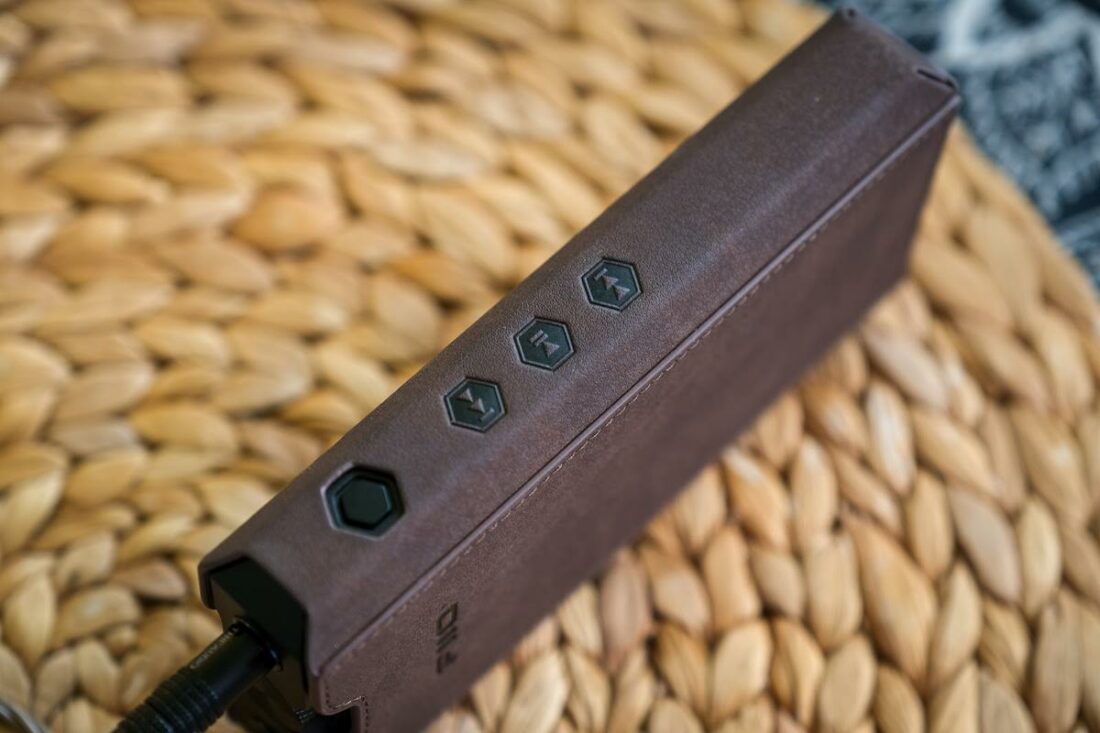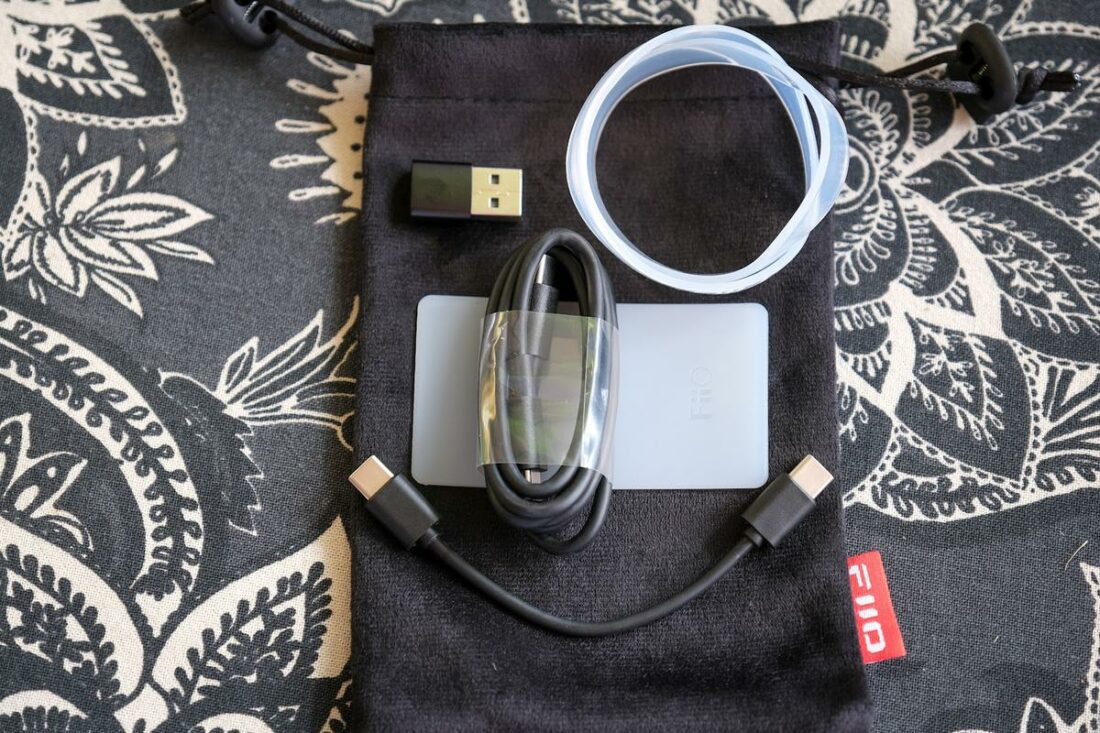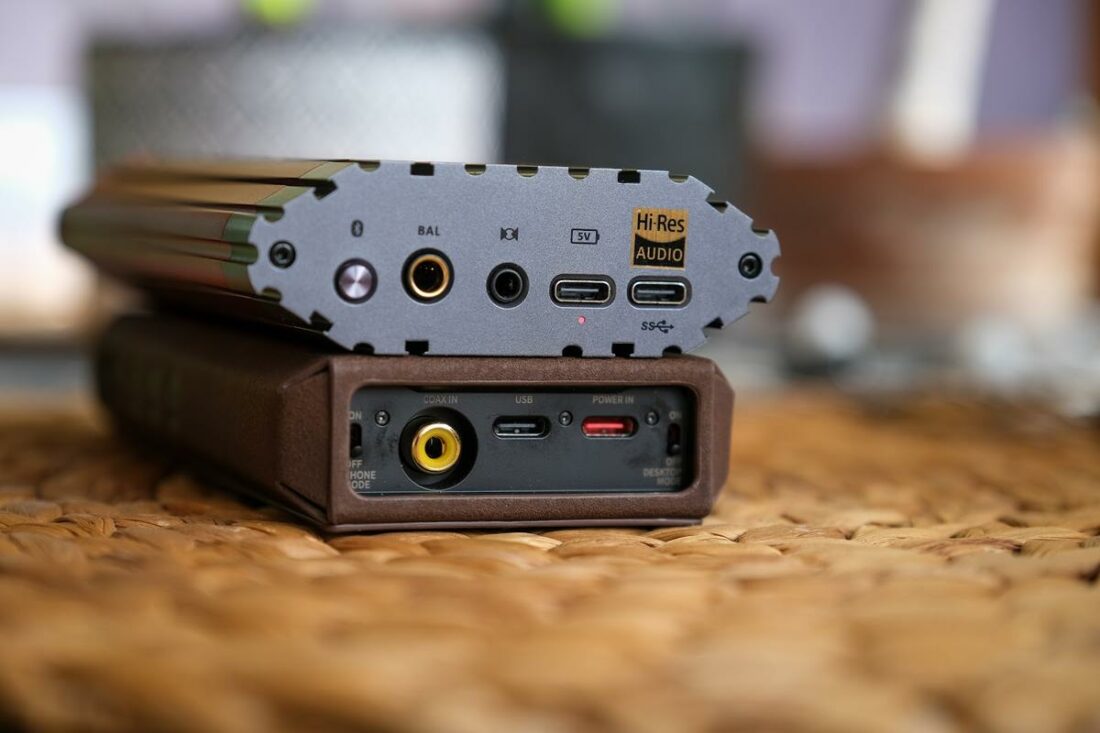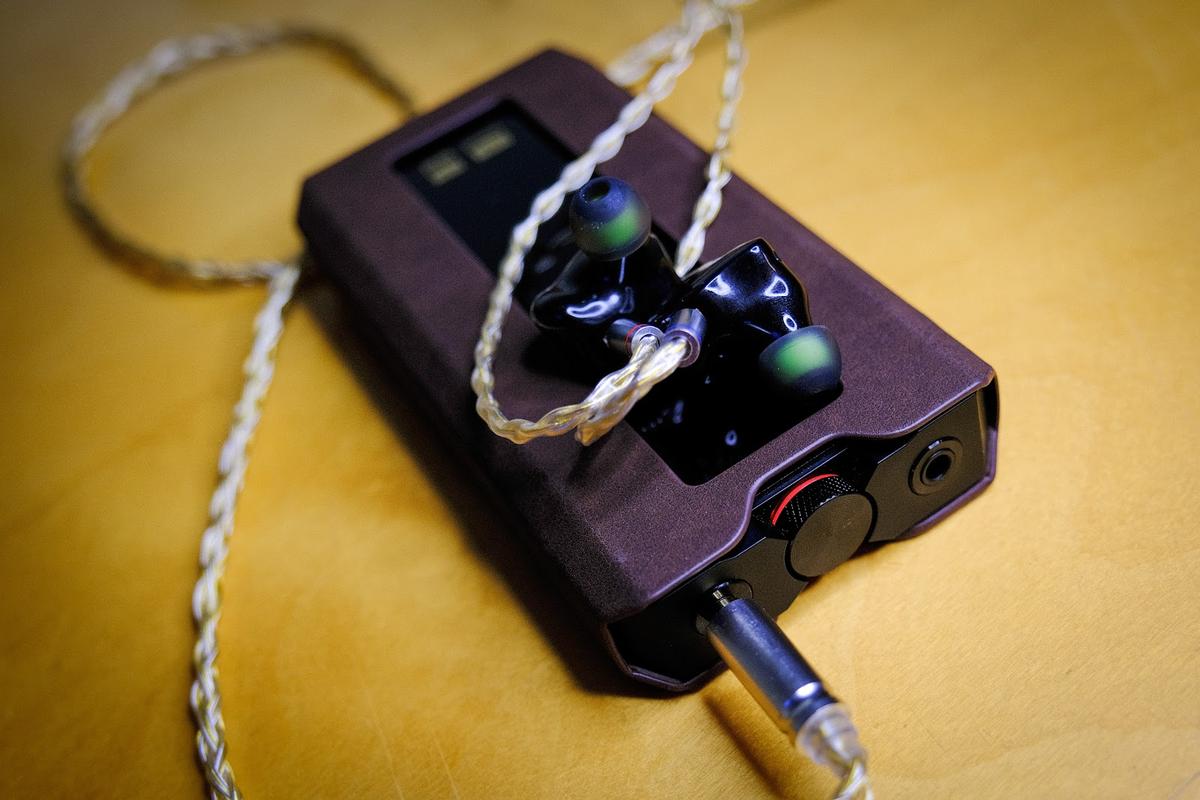Combining desktop-grade sound and power output with a 10-band EQ places the FiiO Q15 in a league of its own.
- Renders realistic timbre and ambiance
- Enough power and gain for most headphones
- It also works well with most IEMs
- 10 PEQ bands are extremely handy
- Great build quality
- Almost too big and heavy to pocket
- Volume control is hard to reach in a pocket
- Single-encoder control is often needlessly fiddly
- EQ switching in USB mode is a hassle
- Some might prefer a more lively sound
FiiO is no stranger to making personal audio electronics in compelling packages; desktop, portable – they do it all! Then there’s the rather niche genre of ‘almost-too-big-to-be-portable’ DAC/amps, where the xDuoo XD05 Pro and iFi Audio iDSD Diablo 2 have recently made their mark.
FiiO’s own Q7, released in 2022, is arguably the granddaddy of the elusive “desktop sound in a portable package.” Coming in at a whopping 620g, it combines a desktop-grade ES9038 Pro DAC with THX AAA 788 amplification. If you have pockets for this beast, you better also have a sturdy belt, lest your pants fall down.
The newer FiiO Q15 has lost some weight while packing AKM’s top-of-the-line chip duo and an opamp analog stage. Will the weight savings be audible? Read on to find out.
One Minute Review Video
Design and Build
FiiO’s Q15 is a dense, dark slab of aluminum and glass. Most of the chassis sports an angle-happy geometric design. On the front, a strip of tempered glass houses a small yet functional 1.3” TFT LCD screen.
FiiO calls it a mecha-inspired design.

All controls are placed on the endplates and left side where the ON/OFF and playback control buttons are. The ends are also where all of the IO is. In terms of outputs, we have 3.5mm for single-ended and 4.4 for balanced, which you can switch to line-level if connecting an external amp.

The lower endplate is more interesting. It has two USB-C inputs, one of which is used for data and power, while the other can be used exclusively for charging. There’s also an RCA port for SPDIF and two toggle switches for phone and desktop mode.
Bluetooth
Like its smaller brethren, FiiO Q15’s Bluetooth capabilities are dictated by the perfectly adequate 5.1 standard. We have all the usual transmission codecs, with lossless being understandably absent.

While I would have liked to see Bluetooth 5.4 with AptX Lossless, I generally don’t miss it due to scarce support in the smartphone world.
Battery
Inside the FiiO Q15 is a 5500mAh Li-Po battery. According to FiiO, it should provide 8-10 hours of runtime. In practice, it’s tough to predict actual battery life as it depends on many factors, like headphone sensitivity, power levels, and energy density of the music.
With IEMs, the 10-hour lifespan ballpark figure seems plausible.

Once dry, the Li-Po pack can be charged with a PD fast-charge capable USB-C charger in 3.5 hours.
Controls
Like many DAC/amps these days, the FiiO Q15 sports a multifunctional encoder that controls volume and can be pressed to choose inputs and long-pressed to enter the menu.
The main menu is quite extensive:
- Gain: Low, Medium, High, Super High
- SE Output: Line level or headphone amp
- BAL Output: Line level or headphone amp
- Line-out Volume: Fixed or Adjustable
- Max Volume: 20 – 120 steps
- Ultra High Gain: Enable automatically or manually
- Filters: Choose from AKM’s low-pass filter list
- Dimmer: Screen brightness options
- Screen Timeout: How fast the screen should go black
- Idle Time: How fast the device should turn off upon inactivity
- Rotate Screen: 90-degree rotation steps
- U-Audio: Choose between UAC 1.0 and UAC 2.0
- MQA Mode: Enable MQA decoding
- PEQ Mode: Choose between default and custom EQ presets
- Language: Choose between English and Chinese
- Factory Reset
- Version
- Telec: Displays the hardware version
- Return
As you can tell, there’s quite a lot to scroll through, and I am annoyed about the lack of a dedicated “back” button. At the end of every page, I have to go down to the “Return” selection to go back.
Mapping one of the three playback controls for “Return” would greatly improve the interface.
Under the Hood
As is customary with these big portables, the FiiO Q15 uses a proper desktop-grade DAC, namely AKM’s AK4499EX + AK4191EQ duo. The musical information reaches it in three ways: via the X316 USB controller, the QCC5125 Bluetooth chip, or a SPDIF receiver that’s not mentioned anywhere in the specs.

After the DAC is an opamp-based analog stage – FiiO is mum about the type of opamps used there. Luckily, the Q15 product page comes with marvelously detailed PCB renders from which I can decipher that there seem to be SG Micro SGM8262 chips doing either IV conversion or amplification (or both).

A highlight in the FiiO Q15s arsenal is the parametric equalizer capability.
It supports 10 custom bands with arbitrary frequency, gain, and Q-factor adjustments, which are accessible via the mobile app. The actual processing is then done by either the USB or the Bluetooth chip, depending on which input is selected.
Software
The FiiO Q15 can be used without installing anything on your phone. However, the FiiO Control app (Apple, Android) is needed to unlock its full potential.
As audio apps go, it’s not too bad. There are some strange slowdowns occasionally, but realistically, you’ll be using it for two things – choosing the Bluetooth codec and dialing in the EQ.

How Does the Q15 Sound?
What initially drew me to review the Q15 was FiiOs decision to use AKM’s top-of-the-line DAC, which I’ve been a big fan of since first meeting it in SMSL SU-9 Ultra. What sealed the deal was the PEQ capability, which can be a game-changer with many headphones and IEMs.

I’m happy to report that the Q15 exhibits the same smoothness and timbral prowess I expected.
It has an almost uncanny ability to render sounds realistically and organically, reminding me of R-2R DACs I’ve tried before. AKM is really onto something with their newest chips.

Tonally, the Q15 is pretty much neutral, with no emphasis on any of the frequency ranges. Some might call it dark-sounding, but that’s mostly due to the smooth nature of the unit. Even in the treble region, there’s plenty of resolution, but the presentation is more subdued Kodachrome than vivid Technicolor.
Comparisons
The closest competitor to the FiiO Q15 I have on hand is the almost four times more expensive iFi Audio iDSD Diablo 2.
The price tag suggests it’s not a fair fight, but their performance tells another story.

In terms of raw technicalities, the Diablo 2 has the edge on the Q15, but it’s not huge. Both units portray details and ambiance very realistically. The Diablo 2 is very energetic in the way it conveys music content, while the Q15 is more of a “smooth operator.”

With PEQ and a well-tuned profile, the Q15 pulls ahead of the Diablo 2 regarding overall sound quality.
The Q15 is also way more usable with IEMs of just about any sensitivity. The low-gain mode allows for a good range of usable volume control and no noise issues. In the upper range of the power band, the Q15 can deliver 1.6 watts versus the 2 (real, not claimed) watts of the Diablo 2.

Where to Buy
Who Should Buy This?
Like the Diablo 2, the FiiO Q15 is huge for a portable unit. Is it good enough to pull the “desktop sound made portable” trick? I think so. The EQ capabilities alone are powerful enough to warrant a purchase.
Luckily, the raw audio performance is also highly compelling.
In terms of pairing, I recommend going for more vivid and exciting-sounding IEMs and headphones. The Simgot EA1000 did great with its dynamic and frequently treble-happy sound signature.
Final Thoughts
In the early days of portable high-end audio, it was common to see people carrying double and even triple stacks of DAC, amplifier, and a digital source. The FiiO Q15 seems quite portable when compared to that bundle.
But now is the age of the dongle, and many will prefer more convenient options even if it has less power and the sound isn’t top-notch.
The real problem facing these gargantuan pocket-ripper DAC/amps is not their limited portability. It’s the inability to appreciate their ability to suss out every detail of the recording when walking around due to skeleton-borne noise and the din of city life. Portability means listening in less-than-ideal environments.
The Q15 comes into its own when sitting in a quiet train or office.
Overall, I enjoyed my time with the FiiO Q15. It finally brings EQ to big-boy DAC/amps and can completely transform how one’s system sounds, provided the owner bothers to dial it in. Powerful enough for just about any headphones and sufficiently silent for IEMs, the Q15 is a Swiss Army knife but with the big blade of a Bowie.
What’s in the Box?
- Q15 DAC/Amp
- USB-C charging cable – 1m
- USB-C data cable – 5cm
- USB-A to C adaptor
- Storage bag
- 2x silicone rings
- Silicon pad
- Manual
- Warranty card
Technical Specifications
- Form: Portable DAC/Amp
- Output Impedance (Ohm): <1 Ohm SE, <1.5 Ohm BAL
- Frequency Response (Hz): 20 Hz – 80 kHz
- THD+N: <0.0005%(1kHz/-9dB @ 32Ω)
- SNR: >126dB(A) line-out, >123dB(A) headphone out
- Output power: SE: 750mW (16Ω, THD+N<1%), 625mW (32Ω, THD+N<1%), 85mW (300Ω,THD+N<1%), BAL: 635mW (16Ω,THD+N<1%), 1610mW (32Ω,THD+N<1%), 340mW (300Ω,THD+N<1%)
- Data rates (USB): PCM – 32bit (44.1 – 768kHz), DoP512
- Data rates (Coax): PCM – 24bit (44.1 – 192kHz coax), DSD64
- Bluetooth Version: 5.1
- Bluetooth Audio Codec: AAC, SBC, aptX, aptX LL, aptX Adaptive, aptX HD, LDAC
- EQ: 10-band parametric EQ (Bluetooth and USB audio only)
- Battery Life (hrs): 8 – 10 hours
- Battery capacity: 5500mAh
- Size: 143.5×71.75×21.75mm
- Weight (g): 305g
